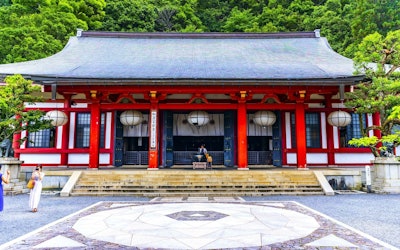Kuramadera Temple is tucked away in the midst of nature in Kyoto City, Kyoto Prefecture. The mysterious mountain, guarded by tengu (heavenly goblins), attracts many tourists as one of the most famous power spots in Kyoto!
Art & Architecture
Video introduction to Kuramadera Temple, Kyoto, Japan, in harmony with beautiful nature.
This video, titled "Kurama-dera Temple - Kyoto - 鞍馬寺," was created by "TokyoStreetView - Japan The Beautiful."
Kurama-dera Temple can be found in Kyoto, a place popular as a scenic sightseeing destination.
The temple stands quietly in the midst of nature.
The temple, located in Kurama, Sakyo Ward, Kyoto City, Kyoto Prefecture, is famous for being the training ground of Minamoto no Yoshitsune and is also the stage for the Noh play Kurama-tengu.
The temple has a long history, first founded 650 years ago by Gantei (鑑禎), a disciple of the monk Ganjin (鑑真).
Gantei was also known as Sonten (尊天).
In the Buddhist world, "Sonten" refers to the trinity of Bishamonten, Senju Kannon, and Goho Mao (also known as Vaisravana, Avalokitesvara, and Sanat Kurama).
Thus, it can be deduced that Gantei was a prolific monk.
The temple’s principal image is the statue of Bishamonten, and the current Kurama-dera temple is the main temple of the Kurama Sect.
The history of Kurama-dera Temple in Kyoto
Photo:Kuramadera Temple, Kyoto
One day, Gantei had a dream in which he was told that there was a sacred mountain in the north of Yamashiro Province. In that mountain, he met a white horse with a precious saddle.
The white horse that appeared on the mountain was the origin of the name Kurama for the temple.
The mountain was later named for the temple, becoming Kurama Mountain.
There is also a legend called the Konjaku Monogatarishu that the god of Kifune Shrine (貴船神社, kifune jinja) near Kurama-dera Temple appeared in front of Fujiwara no Isendo (藤原伊勢人) and instructed him to build a temple enshrining Bishamonten and Senju Kannon.
This is another legend of the origins of Kurama-dera Temple.
What is the principal image of Kurama Mountain, "Sonten"?
Photo:Kuramadera Temple Maoden, Kyoto
Sonten refers to the monk Gantei, as well as the trinity of Bishamonten, Senju Kannon, and Goho Mao.
Bishamonten is one of the four heavenly kings of the Buddhist faith, and is also believed to be a symbol of light and a deity of the sun.
Senju Kannon is the deity of love, a personification of the moon, and has a yin-yang relationship with Bishamonten.
Goho Mao symbolizes power, and is a personification of the Earth.
It is believed that the union of these three deities connect the heavenly realm and the mortal realm.
Although Goho Mao is not very well-known, in actuality, the legend of the tengu of Mt. Kurama as well as throughout Japan is actually referring to Goho Mao.
Goho Mao descended from Venus to the earth 6.5 million years ago, and is said to have immense power.
In Japan, the place where Goho Mao landed is believed to be Mt. Kurama.
Due to the mighty spiritual power of Goho Mao, Mt. Kurama became a significant power spot.
During the Heian Period (794-1185), the mountain was one of the sacred sites for Shugendo.
Highlights of Kurama-dera Temple
Photo:Kuramadera Temple, Kyoto
Kurama-dera Temple is full of mysteries. Here, we'll introduce some charming areas of the temple.
・ Niomon Gate (仁王門, niomon): The entrance to Kurama-dera Temple
・ Genjosui (環浄水, genjosui): Holy water for purification, protected by the statue of the Bodhisattva Kannon.
Visitors must purify themselves before entering to worship.
・ Aun Tiger (阿吽の虎, aun no tora): At Kurama-dera Temple, rather than a komainu lion-dog, a stone statue of a tiger is enshrined as a talisman.
Since ancient times, tigers have been considered to be divine beasts which can ward off evil spirits.
This can be seen from 1:42 in the video.
・ Kongosho (金剛床, kongosho): A stone floor inscribed with a hexagram in front of the main shrine.
The hexagram is an important symbol in the practice of onmyodo (the way of yin and yang).
・ Kondo Main Hall (本殿金堂, honden kondo): Where the principal deities are enshrined.
・ Central Dojo (中心道場, chushin dojo): The training area for monks.
・ Reihoden (霊宝殿, reihoden): Records of the flora and fauna of Mt. Kurama as well as the Yosano Memorial are on display.
・ Tohakutei (冬柏亭): The study of Akiko Yosano. The original building was relocated from Tokyo.
・ Wesaku Festival (ウエサク祭, uesaku-sai): A festival held during the full moon in May every year.
・ Maoden (魔王殿, maoden): The inner temple where Goho Mao is enshrined.
・ Lanterns (灯籠, toro): Lanterns line the stone steps leading from Kurama-dera Temple to Kifune Shrine.
The Kifune Momiji Lantern illumination is a fall tradition.
During the fall foliage season, the crew of the Mount Kurama Cable Railway will serve customers in samue clothing.
・ Yojuji: A restaurant located on Mount Kurama.
At lunch time, it's bustling with worshipers from Kurama-dera Temple.
・ Shuin: Red stamp. Popular as a memento of your visit to Kurama-dera Temple and Kifune Shrine.
Summary of Kurama-dera Temple
Photo:Autumn leaves at Kuramadera Temple, Kyoto
As parking is unavailable, we recommend using the Eizan Electric Railway.
Visitors can walk or take a cable car from Niomon Gate to the main hall.
Along the mountain climbing route, you can enjoy the various sights and vast expanses of nature.
Definitely make some time to visit Mt. Kurama if you go sightseeing in Kyoto.
Also be sure to check the official website for more information, including opening hours for Kurama-dera Temple.
【Tripadvisor】Kurama-dera Temple
https://www.tripadvisor.com/Attraction_Review-g298564-d3444654-Reviews-Kurama_dera-Kyoto_Kyoto_Prefecture_Kinki.html
 Video article 5:32
Video article 5:32 Video article 5:47
Video article 5:47